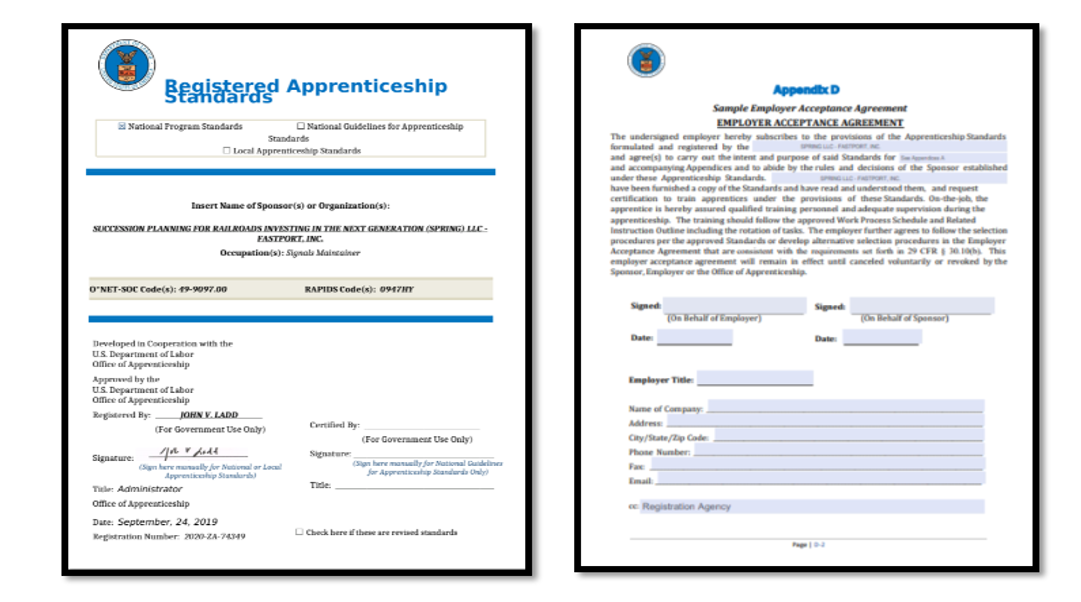Railroad Related Registered Apprenticeships:
In an effort to address the growing need for talent recruitment and retention in the rail industry, SPRING and FASTPORT formed a partnership to combine SPRING’s rail industry knowledge and FASTPORT’s workforce development expertise. In this effort, our network of partnerships and resources developed and implemented, basic training outlines for certain careers, DOL validated Work Processes and a National Program Standard (NPS) of Apprenticeship. The first occupation we established for apprenticability was Signal Maintainers. In conjunction with the Department of Labor (DOL), our training outline for Signal Maintainers became a National Program Standard Apprenticeship program. Now, employers can adopt this NPS and have DOL authorized technical assistance provided by FASTPORT free of charge. Employers review the created standards including the Work Process Schedule (WPS), in layman's terms, a “training outline”. Upon review, the employer may simply adopt the WPS as it is or stipulate modifications that specifically meet their needs. How you train, how you run your program is all up to you, no government entity tells you how to conduct your training. All this acceptance agreement provides is documentation that your organization is providing your training for a certain career path. So, in other words, these outlines to adopt are completely free, and what we, SPRING & FASTPORT, do is provide the skeleton outline that describes what a candidate may be trained on for a said career, signal maintainers, conductors, welders, you name it. You, as the employer, fill in, edit or delete what you need to make it your own.
Your apprenticeship job opportunities are then made visible through the DOL website for candidates to see and find, as an added bonus, increasing your job visibility and tapping into new candidate pools. We have also created a WPS for welders, conductors, and soon engineers and track laborers. SPRING and FASTPORT are here to help connect the dots for employers to take advantage of these programs, get them in place, and help you administratively along the way, at no cost.
Another consideration is if you are a smaller employer who wants to hire veterans, what is going to set you apart from say, the other larger railroads, suppliers, Googles, and Amazons in the world? Your competitive advantage is marginalized when competing on a scale with big salaries and favorable locations, however, that is until you register your career as an apprenticeship. Apprenticeships bolster a 94% retention rate (according to the DOL) and your training program can unlock Monthly Housing Allowances (MHA) benefits to veteran candidates, as noted in the previous chart. You just set yourself up for a strong competitive advantage.
According to the Department of Labor’s Apprenticeship fact sheet, “Employers across the country struggle to find workers with the right skills due to the growing skills gap in the workforce. Help change that by discovering apprenticeship today. Automation or technical innovation alone can’t overcome these challenges. American workers need to upgrade their skills and America’s businesses must become producers of the talent they need to thrive.”
Small Company? Big Advantage
Company A without an apprenticeship, and Company B with an apprenticeship, attract a veteran candidate. If a veteran can make an average of about $1,500 dollars a month while they are going through your training program, in addition to whatever you are going to pay them, which company do you think that candidate is going to consider more heavily? Not a bad advantage and definitely a great recruiting and retention tool for any employer trying to focus attention on veteran hiring. MHA’s can be used and drawn the entire time your apprenticeship/training lasts and it's not coming from your budget, we have the G.I. Bill to thank for that (for those that are eligible). There are just a few things an employer needs to do to have an apprenticeship set up on their property.
All employers need are three simple things; to be an equitable employer, have a paid progression (example: management trainee to trainmaster progression), and provide some type of training with regular managerial reviews. If you have those characteristics, then the last steps are reviewing the skeleton outlines we’ve already created for different jobs and adopt them, or sign the acceptance agreement. Let’s take a closer look.
Here is what the paperwork looks like:
- Employer Acceptance Agreement
- Review WPS or Training outline for that career path (shown is signal maintainers)
- edits can occur up to 20%
Step 1: Sign


